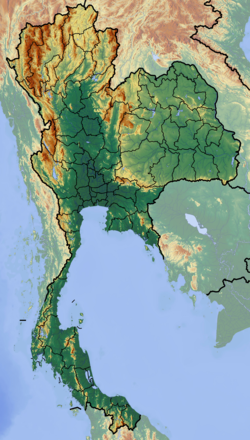Chin Lin
Chin Lin/Kim Lin (金鄰/金邻国) (จินหลิน/กิมหลิน) | |||||||||||
|---|---|---|---|---|---|---|---|---|---|---|---|
| 9 CE–c. 6th century CE | |||||||||||
Proposed locations of Chin Lin | |||||||||||
| Capital | Mueang Uthong? | ||||||||||
| Religion |
| ||||||||||
| Historical era | 9 CE – 6th centuries CE | ||||||||||
• Established | 9 CE | ||||||||||
• Disestablished | c. 6th century CE | ||||||||||
| |||||||||||
| Today part of | |||||||||||
Chin Lin or Kim Lin (Chinese: 金鄰/金邻; Thai: จินหลิน/กิมหลิน; lit. 'golden/wealthy neighbor') was an ancient political entities in modern lower central Thailand exited from the 9 CE to the 3rd century.[1]: 27
In the 3rd century CE, after defeating Tun Sun to control the trans-Kra Isthmus trade route and encircle Chin Lin,[1]: 20, 25 [2]: 258 king Fan Man of Funan attempted to seize Chin Lin,[1]: 20 but failed due to his illness.[3]: 258 [2]: 269
The city "Balangka, an inland town" (บลังกา), mentioned in the Geographike Hyphegesis of Ptolemy in the 2nd century, has been assumed by Thai scholars to have been Mueang Uthong, the center of Chin Lin.[4]: 94 However, some identified Balangka with the ancient Nakhon Pathom.
Location
[edit]The location of Chin Lin remains unclear. It was first mentioned around 9 – 22 CE during the late Western Han period, a Chinese emperor Wang Mang sent an embassy to visit Chin-lin. Later in the 3rd century, Chin Lin was again mentioned in the account of Funan king Fan Shih-man's conquests in the Chinese text Liáng Shū, which states that Chin Lin was located 3,000 li north of the kingdoms of Ta-k'un (Ch'ü-tu-k'un) and Chü-li (Chiu-chih),[2]: 258 speculated to be Kou-chih of Kole polis in present-day near Kuantan of Malaysia.[1]: 26–27 Palmer Briggs proposes that Chin-lin and its southern neighbor, Tun Sun, was the Mon countries. The boundary between this two entities was ill-defined, but probably not far above the present-Mergui-Tanintharyi Region.[2]: 259
List of rulers
[edit]| Ruler | Reign | Notes/Contemporary events | ||
|---|---|---|---|---|
| Rulers before Isanavarman remain unknown. | ||||
| Isanavarman[5] | 5th–6th c. | |||
| Unknown[5] | 5th–6th c. | Son of the previous | ||
| Harshavarman[5] | mid-6th c. | Son of the previous | ||
| Unknown | 8th c. | Mueang Uthong began to lose its prosperity and was probably absorbed by Kamalanka at the ancient Nakhon Pathom, which evolved into a more prominent polity in the 6th century.[6] | ||
| Maratha?[7]: 12 [8]: 97 | late 9th c. | |||
References
[edit]- ^ a b c d e Paul Wheatley (1956). "Tun-Sun (頓 遜)". The Journal of the Royal Asiatic Society of Great Britain and Ireland (1/2). Cambridge University Press: 17–30. JSTOR 25222785. Archived from the original on 26 April 2024.
- ^ a b c d Lawrence Palmer Briggs (1950). "The Khmer Empire and the Malay Peninsula". The Far Eastern Quarterly. 9 (3). Duke University Press: 256–305. doi:10.2307/2049556. JSTOR 2049556. Archived from the original on 26 April 2024.
- ^ Gustaaf Schlegel (1899). "Geographical Notes. VII. Tun-Sun 頓遜 or Tian-Sun 典遜 Tĕnasserim or Tānah-Sāri". T'oung Pao. 10 (1). Brill Publishers: 33–38. JSTOR 4525378. Archived from the original on 26 April 2024.
- ^ Fine Arts Department. โบราณวิทยาเรื่องเมืองอู่ทอง [Archaeology of U Thong City] (PDF) (in Thai). Bangkok. p. 232. Archived from the original (PDF) on 2024-11-10.
- ^ a b c "จารึกแผ่นทองแดง" (PDF). finearts.go.th (in Thai). Archived from the original (PDF) on 8 November 2023. Retrieved 8 November 2023.
- ^ Phanomkorn Navasela (1 May 2018). "นครปฐมเมืองท่าแห่งสหพันธรัฐทวารวดี" [Nakhon Pathom, the port city of the Dvaravati Federation]. Lek-Prapri Viriyahphat Foundation (in Thai). Retrieved 15 July 2025.
- ^ Walailak Songsiri (2025). "ในดินแดนแห่งเจนลีฟู นครรัฐที่ไม่ได้อยู่ในอำนาจทางการเมืองของพระเจ้าชัยวรมันที่ ๗ สู่ปัญหาทางประวัตศาสตร์ที่หาทางออกไม่เจอของสังคมไทย" [In the land of Chen Li Fu, a city-state that was not under the political power of King Jayavarman VII, to the historical problems that cannot be solved for Thai society.]. Lek-Prapai Viriyahpant Foundation (in Thai). Retrieved 14 July 2025.
- ^ Piyanan Chobsilpakob; Pratchaya Rungsangthong (2024). "จารึกสมัยทวารวดีในดินแดนฝั่งตะวันตกของประเทศไทย" [Dvaravati inscriptions in the western part of Thailand] (PDF). Fine Arts Department of Thailand (in Thai). pp. 95–100. Retrieved 15 July 2025.


 French
French Deutsch
Deutsch